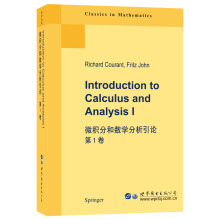Chapter 1 Introduction
1.1 The Continuum of Numbers
a. The System of Natural Numbers and Its Extension. Counting and Measuring
b. Real Numbers and Nested Intervals
c. Decimal Fractions. Bases Other Than Ten
d. Definition of Neighborhood
e. Inequalities
1.2 The Concept of Function
a. Mapping-Graph
b. Definition of the Concept of Functions of a Continuous Variable. Domain and Range of a Function
c. Graphical Representation. Monotonic Functions
d. Continuity
e. The Intermediate Value Theorem. Inverse Functions
1.3 The Elementary Functions
a. Rational Functions
b. Algebraic Functions
c. Trigonometric Functions
d. The Exponential Function and the Logarithm
e. Compound Functions,Symbolic Products, Inverse Functions
1.4 Sequences
1.5 Mathematical Induction
1.6 The Limit of a Sequence
1.7 Further Discussion of the Concept of Limit
a. Definition of Convergence and Divergence
b. Rational Operations with Limits
c. Intrinsic Convergence Tests. Monotone Sequences
d. Infinite Series and the Summation Symbol
e. The Number e
f. The Number r as a Limit
1.8 The Concept of Limit for Functions of a Continuous Variable
a. Some Remarks about the Elementary Functions
Supplements
S.1 Limits and the Number Concept
a. The Rational Numbers
b. Real Numbers Determined by Nested Sequences of Rational Intervals
c. Order, Limits, and Arithmetic Operations for Real Numbers
d. Completeness of the Number Continuum. Compactness of Closed Intervals. Convergence Criteria
e. Least Upper Bound and Greatest Lower Bound
f. Denumerability of the Rational Numbers
S.2 Theorems on Continuous Functions
S.3 Polar Coordinates
S.4 Remarks on Complex Numbers
PROBLEMS
Chapter 2 The Fundamental Ideas of the Integral and Differential Calculus
Chapter 3 The Techniques of Calculus
Chapter 4 Applications in Physics and Geometry
Chapter 5 Taylor' s Expansion
Chapter 6 Numerical Methods
Chapter 7 Infinite Sums and Products
Chapter 8 Trigonometric Series
Chapter 9 Differential Equations for the Simplest Types of Vibration
List of Biographical Dates
Index

 缺书网
缺书网 扫码进群
扫码进群





